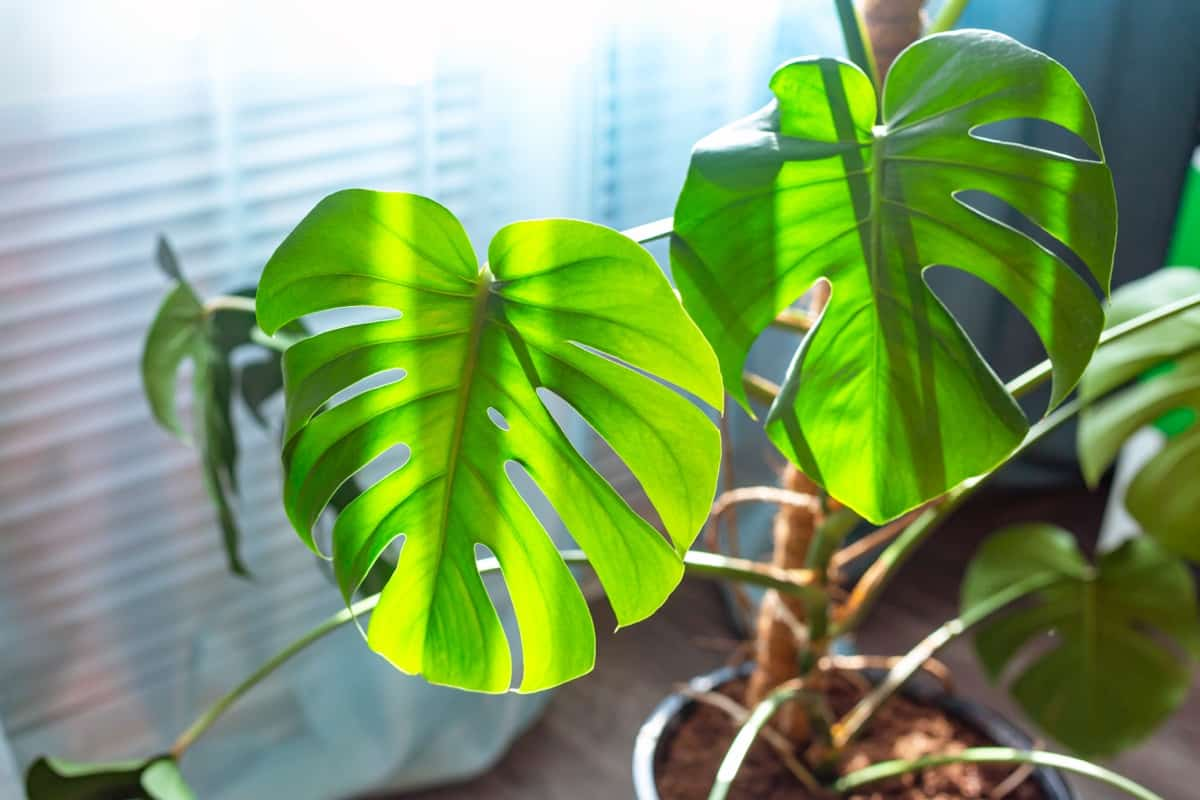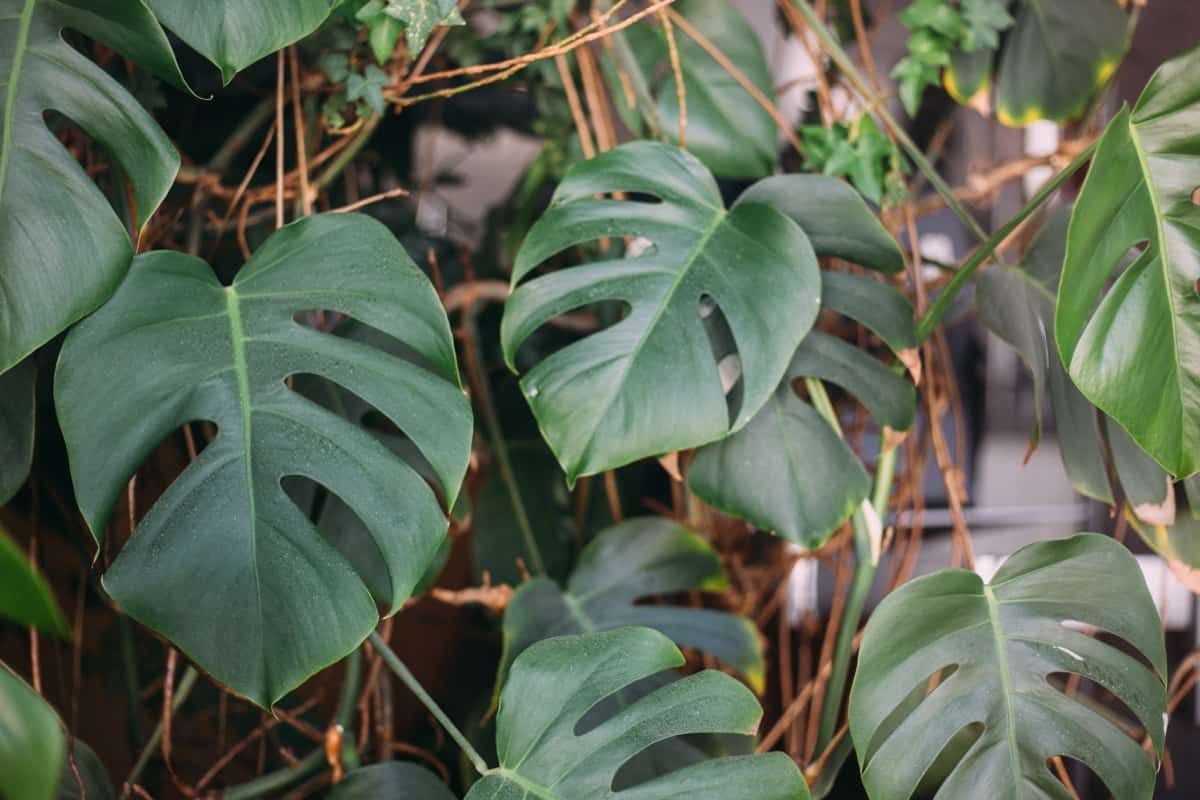Keeping your Monstera plant healthy and vibrant is crucial for its overall well-being. Small leaves on Monstera turning yellow may indicate underlying issues, but you can address them effectively with proper care and attention. Remember to consider factors such as overwatering, inadequate sunlight, nutrient deficiencies, pests, or diseases when diagnosing the cause of yellow Monstera leaves. Once you have identified the problem, several remedies and treatments are available to help restore your plant’s health.

Introduction to Yellow Monstera Leaves: Understanding the Issue
Yellowing Monstera leaves can indicate something isn’t quite right in your plant’s environment or care routine. Environmental conditions such as light, temperature, and humidity are common factors. Monstera plants need bright indirect light, so if exposed to too much direct sunlight or kept in overly dark areas, their leaves may start to yellow.
Another potential cause for yellowing leaves is nutritional deficiencies. Like humans, plants require a balanced diet to stay healthy. If your Monstera lacks essential nutrients like nitrogen or iron, its foliage may show signs of discoloration. Overwatering and poor drainage can also contribute to yellowing leaves. Excess water causes root rot, preventing the roots from properly absorbing necessary nutrients. As a result, the leaves suffer and turn yellow.
Pests and diseases are another culprit behind those unwelcome yellow patches on your Monstera’s foliage. Common pests include spider mites and mealybugs that feed on plant sap and weaken its health. Fungal infections can also cause leaf discoloration in Monstera plants. These infections often occur when excessive moisture is coupled with poor air circulation around the plant’s foliage.
Root rot is another concern leading to yellowing leaves in Monstera plants. This condition occurs when roots sit in waterlogged soil for extended periods due to overwatering or inadequate drainage. Improper fertilization practices can throw off soil nutrient levels, leading to imbalances that manifest as leaf deterioration, including yellowness.
Environmental Factors: Light, Temperature, and Humidity
When it comes to the health of your Monstera leaves, paying attention to environmental factors is crucial. Monstera plants thrive in bright, indirect light. Excess direct sunlight can scorch their delicate leaves, causing them to be yellow and even brown at the edges. Find a spot for your Monstera where it can receive bright but filtered sunlight throughout most of the day. Temperature also plays a significant role in leaf coloration.
Extreme fluctuations or prolonged exposure to cold drafts can stress out your plant and result in yellowing leaves. Similarly, excessively high temperatures without proper ventilation can cause heat stress and discoloration. Dry air can lead to leaf moisture loss through transpiration, resulting in dehydration and yellowing foliage. Consider placing a tray with water near your plant to increase humidity levels.
Nutritional Deficiencies: Identifying and Addressing Imbalances
Nutritional deficiencies can wreak havoc on the health of your beloved Monstera plant, causing its leaves to turn yellow. Identifying and addressing these imbalances is crucial for ensuring the well-being of your green friend. A lack of nitrogen is a common nutritional deficiency that can lead to yellowing leaves. Nitrogen plays a vital role in promoting healthy foliage growth, so if your plant isn’t getting enough, its leaves may start to lose their vibrant green hue.
In case you missed it: 10 Common Problems With Monstera Plants: Treatment and Solutions

Iron deficiency can manifest as yellowing between leaf veins while the veins remain green. This condition, chlorosis, indicates the plant’s lack of iron uptake. Consider using a balanced fertilizer to address nutritional imbalances. These fertilizers typically contain essential nutrients such as nitrogen, phosphorus, and potassium in appropriate ratios.
Overwatering and Poor Drainage: Impact on Leaf Health
Overwatering and poor drainage are common issues that can significantly impact the health of your Monstera leaves. When there is too much water in the soil, it can cause root rot, which in turn affects the plant’s overall health. Excess moisture around the roots prevents them from getting enough oxygen, leading to suffocation and decay. This causes yellowing and wilting of leaves as they cannot absorb nutrients effectively. To prevent overwatering, make sure you have well-draining soil for your Monstera.
Pests and Diseases: Identifying Common Culprits
One of the most notorious pests that infest Monstera plants is spider mites. These tiny arachnids suck the sap from the leaves, leading to discoloration and eventual yellowing. Look out for fine webbing on the underside of leaves or small moving dots. Another pesky intruder is mealybugs. These white, cotton-like insects love to hide in leaf axils and crevices, sucking plant juices along the way.
Their feeding habits can weaken your Monstera’s health and produce yellowing foliage. Aphids are also frequent visitors to Monstera plants. These tiny insects come in various colors (green, black, brown) and congregate on young shoots and undersides of leaves. They pierce through plant tissues with their sharp mouths, causing stress to your green companion.
Diseases like fungal infections can also lead to yellow Monstera leaves. Phytophthora root rot thrives in waterlogged soil conditions, and attacks root systems indiscriminately. Fusarium wilt is another culprit that affects vascular tissues, impeding proper nutrient absorption. Preventing pest infestations involves regular monitoring of your plants’ health and maintaining good hygiene practices, such as keeping your indoor garden clean of debris or fallen leaves.
Root Rot: Causes, Symptoms, and Management Strategies
There are several causes for root rot in Monstera plants. Overwatering is one of the main culprits, as it creates a damp environment that promotes fungal growth. Poor drainage also contributes to root rot by trapping excess moisture around the roots. Root rot symptoms include wilting leaves, Monstera turning yellow and brown, and stunted growth.
If you notice these signs, taking action quickly is important to prevent further damage. To manage root rot in your Monstera plant, remove any affected parts carefully using clean pruning tools. Next, examine the roots for signs of decay or discoloration and trim away any damaged areas. Improving drainage is crucial to preventing future occurrences of root rot.
In case you missed it: 8 Reasons for Monstera Plant Leaf Brown Spots: Treatment, Prevention, and Solutions

Improper Fertilization: Balancing Nutrient Levels for Healthy Leaves
When it comes to the health of your Monstera leaves, proper fertilization is essential. However, using too much or too little fertilizer can have a detrimental effect on their well-being. Over-fertilizing can cause nutrient burn, manifesting as Monstera leaves turning yellow and drooping.
On the other hand, under-fertilizing can lead to nutrient deficiencies, resulting in pale and yellowed foliage. Choosing a fertilizer formulated for houseplants is important to ensure balanced nutrient levels for healthy leaves. Remember that Monstera plants are not heavy feeders and do not require frequent fertilization.
Stress Factors: Transplant Shock, Physical Damage, and More
Uprooting the plant from its familiar environment and placing it in a new pot can cause what is known as transplant shock. This shock often manifests itself through yellowing leaves. Handling the Monstera with care is important during the process to minimize transplant shock. Avoid damaging the roots or tearing any foliage.
Be gentle when removing it from its old pot and place it into a well-prepared new one. Physical damage can also lead to yellowing leaves. Accidental bumps or rough handling may cause bruising or tearing of the foliage. It’s important to handle your Monstera delicately to prevent physical damage that could result in stress-induced leaf discoloration.
Additionally, environmental changes such as temperature fluctuations or direct sunlight exposure can contribute to the stress-related yellowing of Monstera leaves. Ensure that you acclimate your plant gradually to any changes in lighting conditions or temperature so that it has time to adjust without causing undue stress on its system. Remember, prevention is key when dealing with transplant shock and physical damage.
Proper Care and Maintenance: Tips for Preventing Yellow Monstera Leaves
Monstera plants thrive in bright, indirect light. How to fix yellow Monstera leaves? Place your plant near a window but ensure it’s not receiving intense rays. Maintain a temperature range between 18-29°C for optimal growth. Overwatering is among the most common causes of yellow leaves in Monstera plants.
Allow the top two inches of soil to dry before watering again, ensuring proper drainage to avoid root rot. Feed your Monstera regularly during its active growing season (spring through summer). Use a balanced fertilizer every two weeks, or follow package instructions. Should I cut off the yellow leaves on Monstera? Regularly trim any yellow or damaged leaves by cutting close to the main stem with clean shears or scissors.
You can also train your plant by gently tying vines to supports for a better overall shape. Minimize stress factors such as sudden changes in lighting conditions, excessive handling, or moving locations frequently – these can all lead to leaf discoloration. Can yellowing leaves on a Monstera turn green again? Yellowing Monstera leaves on a Monstera plant cannot turn green again.
In case you missed it: How to Tell if Monstera Plant Needs Repotting: 10 Signs You Need to Look For

Conclusion
A variety of factors can cause yellow leaves on Monstera plants. Identifying the specific cause to address the issue and properly restore your plant’s health. Treatments for yellow leaves on Monstera plants may vary depending on the underlying cause. Remember that caring for your Monstera plant requires patience and attentiveness.
Regularly inspecting its leaves for any signs of discoloration and promptly addressing any issues will go a long way in maintaining its overall health and vibrancy. By taking proactive steps and implementing appropriate solutions based on the specific needs of your Monstera plant, you can keep those lush green leaves thriving and enjoy their beauty in all its glory.
- Feed Your Flock for Less: Top 10 Tips to Save on Chicken Feed
- Ultimate Guide to Ossabaw Island Hog: Breeding, Raising, Diet, and Care
- Hatching Answers: The Top 10 Reasons Your Chickens Aren’t Laying Eggs
- Eggs and Economics: Breaking Down the Cost of Raising Backyard Chickens
- Defend Your Greens: Proven Methods to Keep Iguanas Out of Your Garden
- Ultimate Guide to Cinnamon Queen Chicken: A Comprehensive Guide for Beginners
- Ultimate Guide to California Tan Chicken: Breeding, Raising, Diet, Egg-Production and Care
- Ultimate Guide to Marsh Daisy Chicken: Breeding, Raising, Diet, and Care
- 10 Types of Chicken Farming Businesses You Can Start for Profits